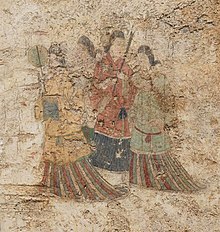Takamatsuzuka Kofun
The Takamatsuzuka Kofun ( Japanese 高 松 塚 古墳 ) is a burial mound from the Asuka period in Asuka , Nara Prefecture in Japan . It is a round hill with a height of five meters and a diameter of 23 m at the base, which tapers up to 18 m.
overview
The grave was discovered by accident in October 1970 when villagers were digging a hole to store ginger. The village of Asuka, which was just celebrating its 15th anniversary (it was made up of three villages), worked in conjunction with the relevant authorities to secure funds for an excavation which finally began on March 1, 1972.
It quickly became clear that the tomb had been robbed, presumably during the Kamakura period . Nevertheless, they made a sensational find: In the burial chamber, which is based on the cardinal points, there were walls painted in color with groups of figures, with the sun, moon and three of the "four gods of the cardinal points" ( 四 神 , Shijin ). The ceiling is decorated with a dot pattern that can be interpreted as a starry sky.
Despite the break-in, the remains of a lacquered coffin and skeletal remains of a man in his forties were found. The robbers had also left a number of objects behind, so that it was possible to date the time when Fujiwara-kyō was the imperial residence, i.e. 690-710. During the break-in from the south side, however, the robbers had destroyed the symbol of the south, the red bird .
It is not yet known who was buried here. The layout and equipment suggest a higher personality. The grave was registered in 1973 as a " special historical site " ( 特別 史跡 , Tokubetsu Shiseki ) and then also raised to the national treasure .
The painting
- East side: sun over the blue dragon , group of four men, group of four women.
- West side: Moon over the White Tiger , group of four men, group of four women.
- North side: black turtle
- South side: badly damaged, no painting preserved
- Cover: 72 red dots, some of which still show remains of gold, which are interpreted as stars around the Little Bear .
The women wear robes as they are known from China of the Sui Dynasty , but especially from Korea. The men wear robes and trousers, as they are well known from China. With the exception of a folding chair, all objects in the paintings, i.e. bags, round fans, priestly objects, have their counterparts in China.
Source:
Remarks
- ↑ The village sees itself as the center of the Asuka culture.
Individual evidence
- ↑ Japan. An illustrated Encyclopedia. Kodansha 1993. ISBN 4-06-205938-X , p. 1508.
- ↑ Sasayama Haruo: Nihon-shi sogo zuroku. Yamakawa shuppan, 8th expanded edition, 2001. ISBN 4-634-02760-7 , p. 21.
Web links
Coordinates: 34 ° 27 ′ 44 " N , 135 ° 48 ′ 23" E

